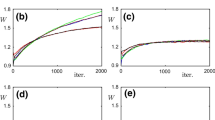Abstract
According to the diffusion approximation and usual approximation scheme, we present two more biologically plausible so called second order spiking perceptron (SOSP) and extended second order spiking perceptron (ESOSP) based on the integrate-and-fire model with renewal process inputs, which employ both first and second statistical representation, i.e., the means, variances and correlations of the synaptic input. We show through various examples that such perceptrons, even a single neuron, are able to perform various complex non-linear tasks like the XOR problem, which is impossible to be solved by traditional single-layer perceptrons. Here our perceptrons offer a significant advantage over classical models, in that they include the second order statistics in computations, specially in that the ESOSP considers the learning of variance in the training. Our ultimate purpose is to open up the possibility of carrying out a stochastic computation in neuronal networks.















Similar content being viewed by others
Notes
The coefficient of variation, \(CV=\sqrt{{\frac{TT}{(T)^2}}}\) , quantifies the irregularity of a spike train. If CV = 0, the spike train is regular, otherwise it is stochastic. In simulations, the initial value of CV is used to initialize the variance of ISIs in the input layer.
References
Abbott LF, Varela JA, Sen K et al (1997) Synaptic depression and cortical gain control. Science 275:220–223
Bohte SM, Kok Joost NJN, La Poutre Han H (2002) Errorbackpropagation in temporally encoded networks of spiking neurons. Neurocomputing 48(1–4):17–37
Brunel N (2000) Dynamics of sparsely connected networks of excitatory and inhibitory spiking neurons. J Comput Neurosci 8:183–208
Fairhall AL, Lewen GD, Bialek W et al (2002) Efficiency and ambiguity in an adaptive neural code. Nature 412:787–792
Feng JF (2003) Computational neuroscience—a comprehensive approach. CRC Press, Chapman-Hall
Feng JF, Brown D (2000) Impact of correlated inputs on the output of the integrate-and-fire models. Neural Comput 12:671–692
Feng JF, Tuckwell HC (2003) Optimal control of neuronal activity. Phys Rev Lett 91:018101
Feng JF, Deng YC, Rossoni E (2006) Dynamics of moment neuronal networks. Phys Rev E 73:041906
Gerstner W, Kistler W (2003) Spiking neuron models. Cambridge University Press, Cambridge
Leng G, Brown CH, Bull PM et al (2001) Responses of magnocellular neurons to osmotic stimulation involves coactivation of excitatory and inhibitory input: an experimental and theoretical analysis. J Neurosci 21:6967–6977
Liu F, Feng JF, Wang W (2003) Impact of Poisson synaptic inputs with a changing rate on weak signal processing. Europhys Lett 64:131–136
Matthews PBC (1996) Relationship of firing intervals of human motor units to the trajectory of post-spike after-hyperpolarization and synaptic noise. J Physiol 492:596–628
Pavlidis NG, Tasoulis DK, Plagianakos VP et al (2005) Neural network training using evolutionary algorithms. In: Proceedings of international joint conference on neural networks (IJCNN’05)
Salinas E, Sejnowski TJ (2001) Correlated neuronal activity and the flow of neural information. Nat Rev Neurosci 2:539–550
Sompolinsky H, Yoon H, Kang KJ et al (2001) Population coding in neuronal systems with correlated noise. Phys Rev E 64(5): 051904
Tuckwell HC (1988) Introduction to theoretical neurobiology. Cambridge University Press, Cambridge
Acknowledgments
The authors would like to thank the any anonymous referees for their useful comments and suggestions. This work was partially supported by National Natural Science Foundation of China (10571051) and Scientific Research Fund of Hunan Provincial Education Department (08C588).
Author information
Authors and Affiliations
Corresponding author
Rights and permissions
About this article
Cite this article
Xiang, X., Deng, Y. & Yang, X. Second order spiking perceptrons. Soft Comput 13, 1219–1230 (2009). https://doi.org/10.1007/s00500-009-0415-3
Published:
Issue Date:
DOI: https://doi.org/10.1007/s00500-009-0415-3




